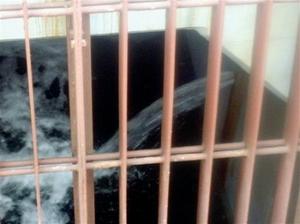Japan disasterRelease of radioactive water into ocean stopped
Radioactive water stopped flowing from Japan’s damaged nuclear power plant into the Pacific Ocean Wednesday after a special material was used, the utility said; the release, which began Monday, was described as an unavoidable process to avert a much bigger problem resulting from the leakage of the highly contaminated water; in terms of volume, about three million gallons of low-level radioactive water will have been dumped into the seas; the flooded basement of the buildings and their underground trenches at Nos. 1, 2, and 3 reactors are believed to hold about 60,000 tons of the more highly radioactive water; this water, which is also preventing workers from doing other emergency work, eventually will be stored in tanks at the reactors’ nuclear waste disposal sites, the government nuclear safety agency said. Those tanks will be shipped by the end of this month, the agency said

Radioactive water spilling from reactor chamber // Source: businessinsider.com
Radioactive water stopped flowing from Japan’s damaged nuclear power plant into the Pacific Ocean Wednesday after a special material was used, the utility said.
Tokyo Electric Power Co. said it injected 1,500 liters (396 gallons) of ”water glass,” or sodium silicate, and another agent near a seaside pit, through which the highly radioactive water had been leaking heavily, Kyodo News reported.
UPI reported that the leak apparently had been seriously contaminating the ocean near the water intake of the plant’s No. 2 reactor. Meanwhile, a Japanese minister has apologized for concern over the dumping of low-level radioactive water from the quake-crippled Fukushima power plant into the ocean.
The release, which began Monday, was described as an unavoidable process to avert a much bigger problem resulting from the leakage of the highly contaminated water.
The plant’s nuclear crisis was set off by the 11 March earthquake and tsunami that killed thousands of people and inflicted damage running into the hundreds of billions of dollars.
The apology Tuesday, directed especially at fishermen, came from Industry Minister Banri Kaieda as he assured the discharge of the low-level radioactive water posed no major health risk, Kyodo News reported. The nuclear safety agency is part of his ministry.
TEPCO, which operates the plant, was releasing the contaminated water as an emergency measure to provide more storage room for the water with much higher contamination in the basement of the reactor buildings.
Kaieda said currently the flooded basement of the buildings and their underground trenches at Nos. 1, 2, and 3 reactors are believed to hold about 60,000 tons of the more highly radioactive water. This water, which is also preventing workers from doing other emergency work, eventually will be removed by the company, the minister said.
As current plans stand, Tokyo Electric plans to dispose o about 11,500 tons of the less contaminated water into the seas by this weekend. The more highly radioactive water is to be stored in tanks at the reactors’ nuclear waste disposal sites, the government nuclear safety agency said. Those tanks will be shipped by the end of this month, the agency said.
Before that happens, the utility must ensure there is no more radioactive water leaking from the facility.
The leakage of the radioactive water into the seas was believed to be coming from a cracked pit in the No. 2 reactor, which lost its cooling system, leading to the partial melting of the uranium fuel rods. The leaking
